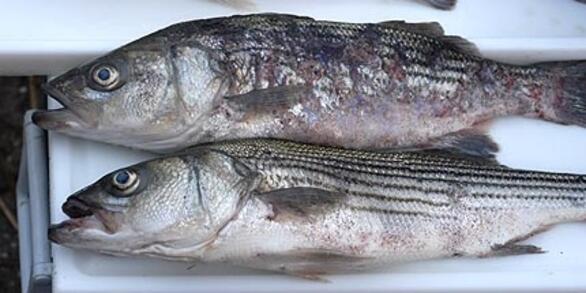Fish and Aquatic Species Conservation
Fish and Aquatic Species Conservation
At the Eastern Ecological Science Center (EESC), we strive to provide world-class science to inform natural resource decisions that preserve and enhance our quality of life.
Filter Total Items: 89
Monitoring Vernal Pool Amphibians in the Northeast
In 2004, the Northeast Amphibian Research Monitoring Initiative (NE ARMI) in collaboration with National Park Service and US Fish and Wildlife Service initiated a region-wide study on the distribution of vernal pools and estimate the proportion of pools that were occupied by pool-associated amphibians (specifically, wood frogs, Lithobates sylvaticus, and spotted salamanders, Ambystoma maculatum).
Northeast Amphibian Research and Monitoring Initiative
The U.S. Geological Survey’s Eastern Ecological Science Center is home to the Northeast Amphibian Research and Monitoring Initiative (NEARMI), one of 7 ARMI regions across the United States. NEARMI works on public lands in thirteen states from Maine to Virginia, including many National Parks and National Wildlife Refuges.
Study reveals importance of groundwater for stability of freshwater fish populations and resilience to climate change
Issue: Climate change is warming streams and rivers of the Chesapeake Bay watershed, and this is a critical concern for fisheries management and conservation. To address this issue, the Chesapeake Bay Program (CBP) recently identified four actions: • address the threats of climate change in all aspects of the partnership’s work; • prioritize communities, working lands, and most vulnerable habitats...
Brook trout vulnerability to drought: eastern component of USGS national integrated ecohydrological research
There is a growing and urgent need to develop and implement innovative strategies to research, monitor, and manage freshwater resources as societal demands escalate simultaneously with climate-driven changes in water availability.
Fish and Aquatic Animal Health Publications, 2021 – 2022
Below are journal articles about fish and aquatic animal health from the Eastern Ecological Science Center published in 2021 and 2022.
READI-Net: Providing Tools for the Early Detection and Management of Aquatic Invasive Species
The USGS has developed the Rapid environmental (e)DNA Assessment and Deployment Initiative & Network (READI-Net) to accelerate the implementation of environmental DNA (eDNA) analysis as a best practice for the early detection of aquatic biological threats. READI-Net provides tools and a strategy to collect and deliver early detection data for natural resource managers and public health protection...
By
Ecosystems Mission Area, Biological Threats and Invasive Species Research Program, Columbia Environmental Research Center, Eastern Ecological Science Center, Forest and Rangeland Ecosystem Science Center, New York Water Science Center, Northern Rocky Mountain Science Center, Upper Midwest Environmental Sciences Center, Wetland and Aquatic Research Center , Wyoming-Montana Water Science Center, Pacific Northwest Environmental DNA Laboratory, Infrastructure Investment Jobs Act
Invasive Blue Catfish Science to Support Conservation and Fisheries Management
Dietary analyses, health, and reproduction of blue catfish in tributaries of the Chesapeake Bay inform ecosystem impacts and mitigation strategies for this aquatic nuisance species.
Assessing the habitat conditions to support freshwater fisheries in the Chesapeake Watershed
Issue: The Chesapeake Bay Program partners are striving to improve habitat conditions for recreational fisheries and other native fishes in the Bay and its watershed. While national fish habitat assessments have been conducted, resource managers need more local information to focus restoration and protection efforts in Chesapeake Bay watershed. Conducting the fish-habitat assessments are...
Enabling AI for citizen science in fish biology
Artificial Intelligence (AI) is revolutionizing ecology and conservation by enabling species recognition from photos and videos. Our project evaluates the capacity to expand AI for individual fish recognition for population assessment. The success of this effort would facilitate fisheries analysis at an unprecedented scale by engaging anglers and citizen scientists in imagery collection. This...
Eastern Ecological Science Center partnership with Atlantic States Marine Fisheries Commission
Collaboration between the world-class expertise of USGS scientists, the Atlantic States Marine Fisheries Commission’s Science Program, and state and federal fishery agencies demonstrates the power of partnerships to solve seemingly-insurmountable problems in sustainable and cooperative management of Atlantic coastal fisheries.
Time marches on, but do factors driving instream habitat and biology remain consistent?
Issue: Stream ecosystems are affected by a complex set of interacting terrestrial and aquatic stressors. With many streams experiencing degraded conditions that often correspond with increased anthropogenic activities, an important outcome of the Chesapeake Bay Program is to improve stream health. The USGS is conducting research to better understand the complex factors affecting stream health...
Terrestrial wildlife and legacy oil mining on National Wildlife Refuges
Amphibian surveys are being conducted on select National Wildlife Refuges with active and/or legacy oil mining to determine species relative distribution and their risk to short- and long-term effects from exposure to crude oil and its byproducts.















